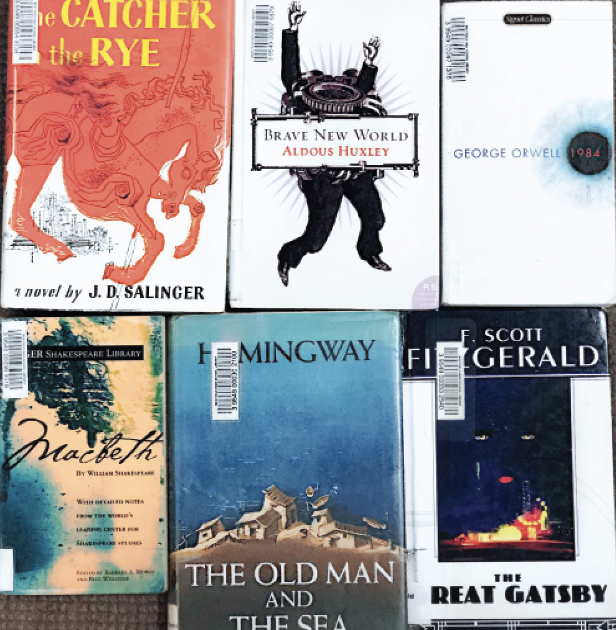Where are the minorities in literature?
Photo Audrey Pucciarelli
Books in English curriculum at WHS
During my time at WHS, I have read 24 novels. All of them are written by renowned authors. However, as I enter the second semester of my senior year, I have noticed a trend in a lot of the literary works I have read at WHS: minorities are either depicted in a negative light or not represented at all, and the novels are rarely written by minorities.
I have always been subconsciously aware of this fact in my English classes. Since middle school, I have read, analyzed and written about the role of female characters in literature. Usually, the women I read and write about are weak or manipulative and often lead to the male hero’s downfall.
As an avid reader, I have looked up to the female figures I read about. In first grade, I wore dresses and skirts to school every day because that’s what I saw princesses wearing in fairy tales. Over time, these princesses got replaced by female heroines like Hermione Granger and Elizabeth Bennet who inspired me to reject the cliche role of the damsel in distress.
But these are all novels I read outside of school. For example, any Shakespeare work I have read in class—Romeo and Juliet, Othello, Macbeth and Hamlet—all teach women that they should be subservient to men. Even Frankenstein, which is written by the female author Mary Shelley, has a female character who encourages the idea that all women should strive to be the perfect lady. Characters teach people how to behave. Having most of the female characters obey men teaches female students that they should be that way as well.
Yet, women should consider themselves lucky because at least they make an appearance in novels. With the exception of one book on Native Americans and five novels with a black character, no other races have been represented in the novels I’ve read in school.
It is no secret that WHS is a predominantly white school. How do you learn to appreciate different cultures? The answer is simple: you learn about that culture. What better way to learn about the rich history of black culture, especially in the United States, than reading about it from African American authors?
One of my favorite literary works I’ve read in class was A Raisin in the Sun by Lorraine Hansberry, an African American playwright. Through this play, I was able to understand more about what it was like being an African American during Hansberry’s time. If we incorporate more minority voices in our curriculum, students will likely become inspired and more understanding of other cultures.
However, the lack of race and gender representation is not just something WHS struggles with. Most novels that are considered classics are written by white males; therefore, these texts lack the representation that minority groups strive for today.
“It’s kind of a struggle that we experience as a nation when it comes to secondary education in the English classroom,” said Supervisor of English Language Arts Dr. Tiffany Jacobson. “There are these two competing schools of thought: Do we teach the works of the [classics]? Do we bring in more relevant, contemporary fresh voices and perspectives?”
According to Dr. Jacobson, WHS tries to solve this problem by encouraging teachers to read the classics from the curriculum with the students, but also bring in more modern supplements to give a 21st century perspective and more minority voices and perspectives.
“I think we always kind of have to remind ourselves of the fact that literature is very much social commentary,” said Dr. Jacobson about the lack of representation in literature. “It’s a reflection of the times in which the piece was written and so for better or worse we have that context that we need to grapple with and make sense of.”
While this struggle between reading the classics that feature white men and reading materials that fit into the modern world will continue, it is important to recognize that many of the views expressed about minority groups in novels are outdated. Even though students may not read a lot of novels with minority voices in the classroom, they should be encouraged to seek out these voices and experiences through literature elsewhere.

